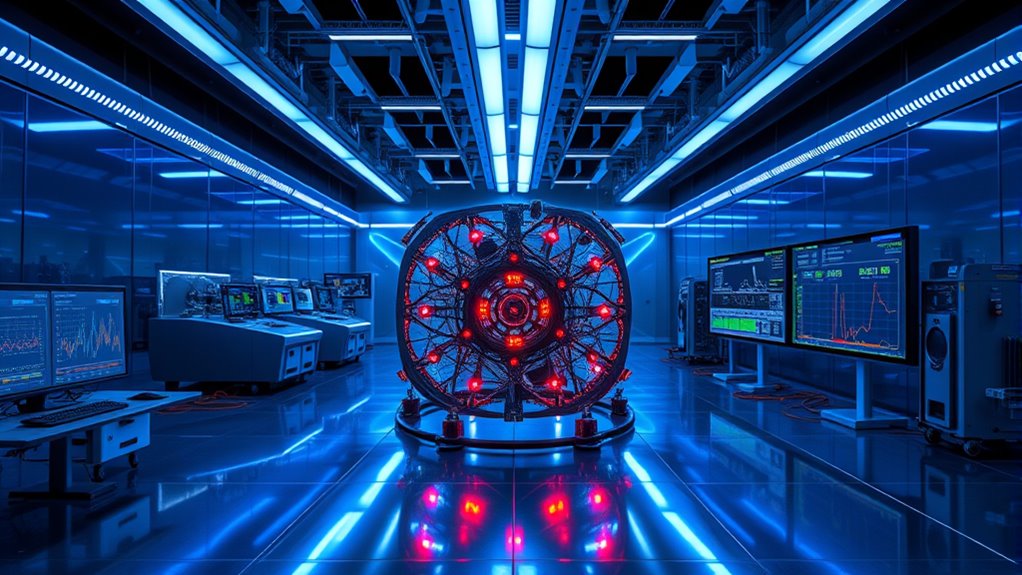Recent experiments with muons show deviations from what the Standard Model predicts, which hints at the possibility of new particles or forces. Quantum fluctuations and their unpredictable effects could be behind these anomalies, impacting muon decay and magnetic properties. This evolving mystery challenges current physics and suggests there’s more to uncover about our universe’s fundamental structure. If you keep exploring, you’ll uncover fascinating insights into what might lie beyond our current understanding.
Key Takeaways
- Recent muon experiments show deviations in magnetic moments, suggesting potential new physics beyond the Standard Model.
- Quantum fluctuations may influence muon decay and magnetic properties, complicating measurements but hinting at unknown phenomena.
- Persistent anomalies across studies reinforce the possibility of undiscovered particles or forces affecting muon behavior.
- Advanced detectors are refining measurements to confirm if these deviations are genuine indications of new physics.
- Confirming these anomalies could revolutionize our understanding of fundamental particles and the universe’s underlying structure.

Have scientists uncovered more questions about the elusive muon? It’s a question that’s been lingering since recent experiments hinted at anomalies in how muons behave. These subatomic particles, similar to electrons but much heavier, are notoriously tricky to study. When you explore into their world, you encounter phenomena like quantum fluctuations—tiny, unpredictable changes in energy levels that occur constantly at the quantum level. These fluctuations influence how muons interact with their environment, affecting their magnetic properties and decay patterns. The experiments suggest that the muon’s magnetic moment deviates from what the Standard Model predicts, hinting at the possibility of unknown forces or particles lurking beyond current understanding. Additionally, the role of regional flavors and traditions in experimental design can influence the interpretation of results, emphasizing the importance of diverse approaches in scientific research.
Are muon anomalies hinting at new physics beyond the Standard Model? Quantum fluctuations may hold the key.
Your curiosity might lead you to contemplate the nature of particle decay. Muons are unstable; they decay into electrons and neutrinos within microseconds. But the way they decay, and the energy they release during this process, could hold clues to new physics. If quantum fluctuations are more pronounced than expected, they might subtly alter decay rates or the magnetic moment of the muon, influencing the data scientists observe. These tiny effects, though difficult to detect, could be the key to revealing deeper layers of reality. The fact that these anomalies persist across multiple experiments suggests that something fundamental is missing from the current theoretical framework.
As you follow the research, it becomes clear that scientists are pushing the boundaries of precision measurement. They use advanced detectors to track the muon’s behavior with extraordinary accuracy, looking for discrepancies that might point to new particles or forces. When a muon decays, it’s not simply a straightforward process; quantum fluctuations can introduce variations that are challenging to predict and measure. These fluctuations can influence how the muon’s magnetic moment shifts over time, adding complexity to the puzzle. The ongoing experiments aim to refine these measurements, hoping to confirm whether the deviations are genuine signals of new physics or just statistical flukes.
Ultimately, the mystery deepens because the muon’s behavior touches on core questions about the universe’s fundamental structure. If these anomalies are confirmed, they could revolutionize physics, revealing phenomena beyond the Standard Model. For you, it’s a reminder that even the smallest particles can hold enormous secrets, and that persistent curiosity and cutting-edge experimentation are essential to uncovering them. The muon’s strange behavior challenges our understanding of quantum fluctuations, particle decay, and the very fabric of reality—an intriguing puzzle that might lead to a new era of physics.
Frequently Asked Questions
What Are Muons and How Are They Produced?
Muons are subatomic particles similar to electrons but heavier. You produce muons mainly through cosmic rays striking Earth’s atmosphere, causing particle showers. When cosmic rays hit atoms, they create muons that decay quickly through muon decay, transforming into electrons and neutrinos. You can detect these muons at the surface, and their behavior helps scientists explore fundamental physics, including the mysteries surrounding the muon’s properties and decay processes.
How Does the Muon G-2 Experiment Work?
You observe the muon g-2 experiment by measuring how muons behave in a magnetic field, focusing on their spin precession. The experiment detects quantum loops and particle interactions that influence muon behavior, causing tiny differences in their magnetic moment. By comparing these measurements to theoretical predictions, you can identify anomalies that might indicate new physics beyond the Standard Model.
What Implications Does This Discovery Have for the Standard Model?
Imagine discovering a hidden chapter in your favorite book—this is what the muon experiment hints at for particle physics. If confirmed, it could challenge the standard model, the framework guiding our understanding of fundamental particles. This discovery suggests there might be new physics beyond current theories, prompting scientists to rethink established ideas and explore uncharted territory in the universe’s fundamental laws, like uncovering a secret level in a classic video game.
Could This Lead to New Particles or Forces?
You might wonder if this discovery could lead to new particles or forces. It’s possible because the anomaly hints at physics beyond the standard model, potentially involving dark matter or quantum gravity. If confirmed, scientists could uncover previously unknown particles or forces that influence fundamental interactions, helping us better understand the universe’s composition and the forces shaping it. This could open doors to revolutionary advancements in physics.
When Will Further Experiments Clarify These Findings?
Like waiting for a comet’s return, you wonder when new experiments will clarify these findings. Researchers anticipate results within the next few years, but theoretical implications and experimental challenges mean progress isn’t immediate. You’ll need patience as scientists refine techniques and gather more data, much like explorers charting unknown waters. Ultimately, these efforts will reveal if we’re glimpsing new particles, forces, or just deeper mysteries in physics.
Conclusion
As you stand on the cusp of discovery, this muon experiment feels like stepping into a sci-fi flick, where the universe keeps whispering secrets just out of reach. Though the results challenge current theories, they also ignite your curiosity, hinting at new physics lurking beyond the horizon. Just as explorers once gazed at distant stars, you’re now peering into the unknown, enthusiastic to unravel mysteries that could reshape our understanding of reality—like discovering a hidden room behind the wardrobe.









